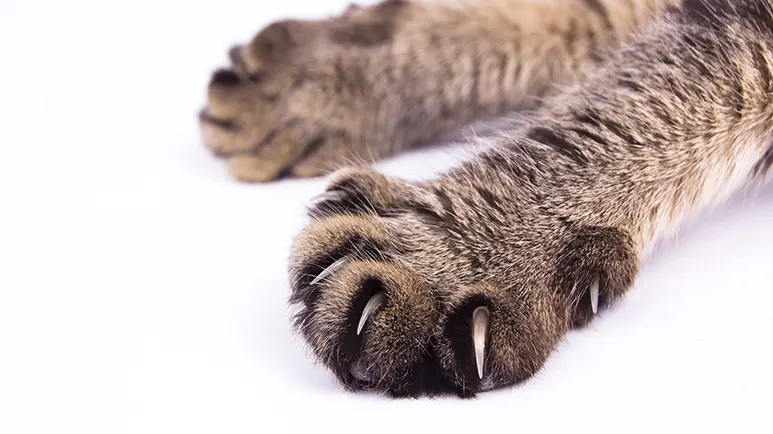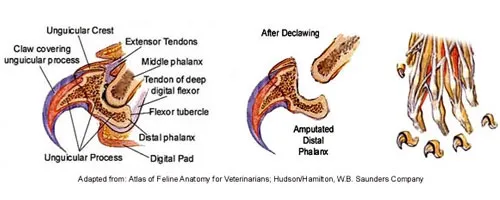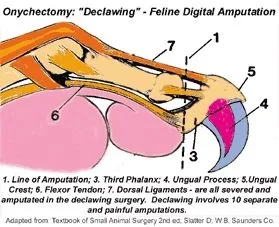New Law Set to Shake Up Cat Care in Virginia
Discover how upcoming legislation is changing the rules for cat owners and veterinarians, and what it means for your feline friends starting this summer.

STORY AT-A-GLANCE
- Since July 1, 2024, another state, Virginia, has enforced a ban on declawing cats except in certain situations
- Only a handful of U.S. states have banned the inhumane practice, however, many entire countries, including Australia, England, France, Spain and Sweden, have outlawed the practice
- It’s a myth that declawing is no more painful or harmful than a nail trim; it involves amputation of the claw, bones, nerves, the joint capsule, collateral ligaments and the extensor or flexor tendons
- The procedure often results in chronic pain and nerve damage, along with residual inflammation and neuropathic pain; it can also inflict emotional stress on cats and behavioral changes, such as aggression and inappropriate elimination
- It’s important to take steps to prevent your cat’s sharp little claws from doing damage to your furniture, carpets, drapes, and other surfaces around your home
Editor's Note: This article is a reprint. It was originally published June 22, 2024.
Since July 1, 2024. veterinarians in Richmond, Virginia are no longer allowed to declaw cats unless there are certain “therapeutic” reasons to do so.
The bill (HB 13541) was brought forward by Del. Marty Martinez, who represents House District 29 (Loudoun). Representatives for PETA, the Virginia Veterinary Medical Association, and the Richmond SPCA spoke in favor of the bill in a House subcommittee meeting in January of this year.
The bill passed the House of Delegates 58 to 41, and the VA Senate 25 to 13. As reported by FOX8 news, Gov. Glenn Youngkin has signed the bill into law.2 The therapeutic exceptions to the declawing ban include:
- To address an existing or recurring infection, disease, injury or abnormal condition in an animal’s claw, nail bed or toe bone that jeopardizes the animal’s health, and for which addressing the infection, disease, injury or abnormal condition is a medical necessity, as documented by a licensed veterinarian
- To protect the owner’s life or health, as documented by a licensed physician, when such owner has been diagnosed with an infection, disease, disorder or similar condition that could reasonably be expected to worsen if such owner were to be scratched by a cat
In 2019, New York became the first U.S. state to ban the practice.3 Maryland followed suit, with its ban taking effect October 1, 2022,4 and Illinois has introduced legislation to make the procedure illegal.5 However, the U.S. is behind the curve, as many countries, including Australia, England, France, Spain and Sweden, have already outlawed the practice.6
Declawing Is Inhumane and Almost Always Unnecessary
It’s a myth that declawing is just a harmless “permanent nail trim.” In fact, the term declawing is quite misleading. The procedure should actually be called “de-toeing,” because declawing implies only a cat’s claws are permanently removed. However, it’s impossible to remove the claws without amputating a portion of each toe.
More specifically, declawing isn't a nail trim or even nail removal. It's amputation of the claw, bones, nerves, the joint capsule, collateral ligaments and the extensor or flexor tendons, as you can clearly see in these two images:


A front-paw declaw requires 10 separate amputations. If the hind paws are also done, that's 8 more separate amputations. Fortunately, hind paw declawing is much less common, but also considerably more painful for the cat.
According to feline specialist Dr. Jean Hofve, declawing is so painful it is the procedure of choice to test new pain medications for cats.7 Believe it or not, everyone in the veterinary community understands it's a more painful procedure than spaying or neutering.
In addition to the mutilation of their toes, cats use their paws to bear weight, which makes sitting up, and especially standing and walking, torturous. Most cats are sent home with just two or three days of pain medication. As we know, kitties hide pain exceptionally well, so while they may seem fine, the pain of declawing is still with them for much longer than a quick 48 hours.
Declawing can also create chronic, severe pain in a number of ways, and cats, being stoic, deal with it. They appear normal. They may even get back to playing. They may "pretend" to scratch with their missing front claws. They may climb and jump, but none of it is normal movement because declawing has altered their entire physiology. Their biomechanics have changed, and down the road, behavioral problems can arise.
There are immediate and obvious behavior changes in about one-third of declawed cats, like biting and eliminating outside the litterbox. But there are also mental and emotional problems that can develop. Lots of owners of declawed cats report that their pet has become depressed, withdrawn, irritable, and even aggressive after being declawed. Of course, this is to be expected if every step a cat takes causes pain. And while owners may not associate the behavior change with pain because cats are stoic, pain is usually the cause of it.
The good news is the majority of housecats these days aren't undergoing brutal toe amputations. The not-so-good news is that unless you take steps to prevent it, those sharp little claws can do big-time damage to your furniture, carpets, drapes, and other surfaces around your home.
Tips to Redirect Problem Scratching
In a 2022 study, 58% of cat owners reported that their pet engaged in “inappropriate scratching.” Fortunately, most agreed that they’d rather provide additional scratching surfaces or items for their cat to scratch instead of surrendering them to a shelter or declawing them.8
The study found unwanted scratching was less reported by owners who provided enrichment items, safe outdoor access and positive reinforcement training, as well as owners who restricted access to items they didn’t want scratched. A good rule of thumb to encourage your cat to scratch where you want her to, such as on a scratching post, is to have one more scratcher than you have cats.
So, if you have two feline family members, a good rule of thumb is to have three scratching surfaces. Many cats don't like to share their scratching territory. Rub some organic catnip on the scratcher and praise your cat whenever she uses it.
Make sure her scratching post is located in an area she enjoys being in, and offer a variety of surfaces, such as carpet- and sisal-covered posts, both horizontally and vertically aligned. Some cats also enjoy scratching on wood, fabric or cardboard.
If your kitty is scratching somewhere she shouldn’t, use deterrents to make the spot less attractive, Aluminum foil, double-sided tape and even inflated balloons attached to the area may keep your cat away. You can also spray a mist of lemon essential oil in spots you want to keep her away from, as most kitties don’t like the scent of citrus.
You’ll also want to keep your cat’s nails trimmed regularly. Trim twice a month, which will minimize damage from scratching and may even make your cat scratch less often because the nails are blunt, rather than sharp.
Nail caps can also be used if all else fails, but in most cases, when you provide appropriate scratching spots, remove the temptation to scratch where they’re not supposed to and keep your cat’s nails trimmed, scratching won’t be a problem. Remember, the goal isn’t to stop your cat’s scratching behavior — it’s to encourage her to scratch in the appropriate spots.
Sources and References
- 1 Virginia's Legislative Information System, 2024 Session, HB 1354 Cats; prohibition on declawing
- 2 FOX8 Greensboro, April 17, 2024
- 3 NPR/KNPR, July 23, 2019
- 4 WUSA9, April 25, 2022
- 5 5Chicago, March 17, 2023
- 6 PETA, August 24, 2022
- 7 Little Big Cat, May 17, 2013
- 8 Cisneros, A. et al. Animals (Basel). 2022 Oct; 12(19): 2551











